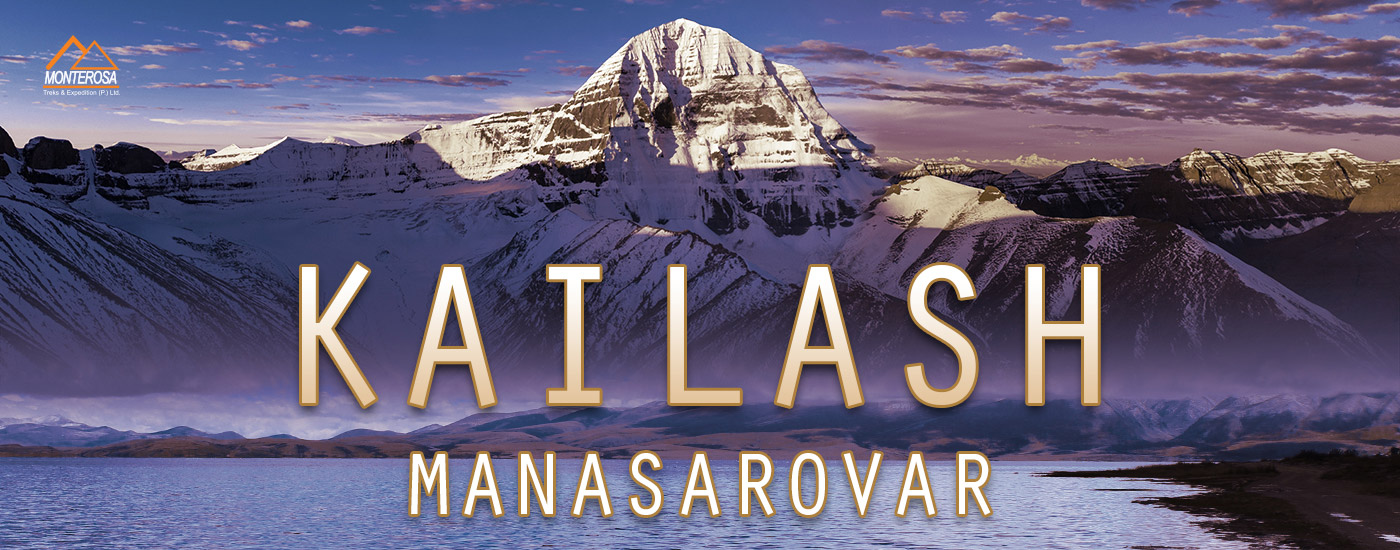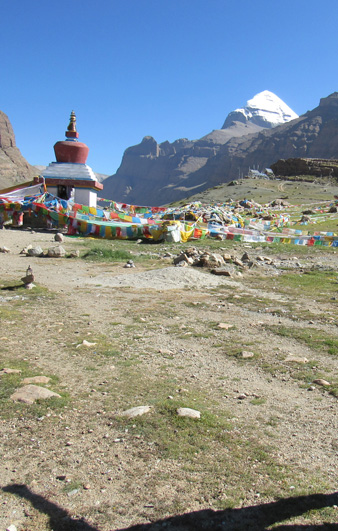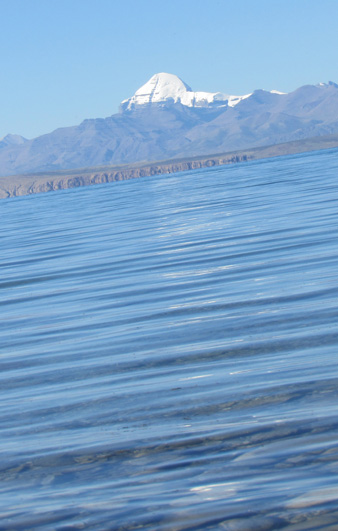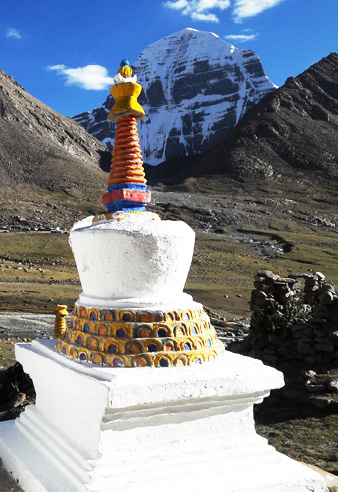
Mount Kailash, also known as Kangri Rinpoche to the Tibetans, has long been a fascination for travelers from around the globe as a symbol of fortune and good luck. Dedicated to Buddhism, Hinduism, Jainism and Bonpo, it is the ultimate spiritual shrine. Kailash stands at 6714 meters above sea level and is the source of four of Asia's biggest rivers: Brahmaputra, Indus, Karnali and Sutlej. According to Hindu belief, Mount Kailash is the exclusive abode of Lord Shiva and Goddess Parvati. As the place where Buddha meditated and attained enlightenment, it is revered by Buddhists as Kangri Rinpoche. Before achieving liberation and freedom, the first saint meditated here, according to the Jains. The peak however, is hailed as the ultimate savior of the world by Bonpo. To pay homage to their gods, thousands of pilgrims travel to the Mount Kailash and Lake Manasarovar every year.
In Tibetan culture, enlightenment can be achieved by making a kora or complete circumambulation of the mountain at least once. In Hinduism and Buddhism, completing pilgrimages to Kailash and Manasarovar helps to wash away sins and attain salvation. A total distance of 53 km of 38 KM must be covered on foot to make a complete circuit around the mountain. (moksha). Mapam Yumtso Tibetan or Lake Manasarovar, as well as Mount Kailash, hold a special place in the hearts of all travelers (Tirth Yatri). It is believed that dipping in the lake of Manasarovar will cleanse the human soul of all sins, according to Hindus. Both Lhasa and Kathmandu (Nepal) are easily accessible from Tibet, which is located in the southern province of China.
Monterosa Treks & Expedition is here to make your dream of visiting this divine place a reality. It will be an unforgettable holy trip with us. Please feel free to contact us at any time. It is "OM NAMO SIVAYE" that Har Har Mahadev.
The meeting point is: Upon arrival at Tribhuvan International Airport, our staff will welcome you and take you to your hotel.
29 June 2025 Day 01: Arrival in Kathmandu before 08:00 AM
Collect passport, Apply Tibet and evening Arati Pashupatinath
30 June 2025 Day 02: Holy sightseeing Kailashnath Saga and
Doleshwor Mahadev, Lunch & after Boudhanath, Guhyeshori
01 July 2025 Day 03: Rudrabhishek and visiting in Jal Narayan
02 July 2025 Day 04: Start: Drive to Trisuli and Ghatte Khola
03 July 2025 Day 05: Cross Nepal Tibet boarder, drive Kerung
04 July 2025 Day 06: Drive to Saga Bazaar & overnight Saga
05 July 2025 Day 07 Acclimatization, day walking around Saga
06 July 2025 Day 08: Drive to Hor, Manasarovar Lake & drive darchen
07 July 2025 Day 09: Drive to Yam Dwar and walk to Dirapuk
08 July 2025 Day 10: Climb up touch Kailash / Charan Sparsh
09 July 2025 Day 11: Start walking to Zuthulpuk (kora 4th day)
10 July 2025 Day 12: Walking Chongdo, drive to Manasarovar
Full moon night in Manasarovar Lake (Guru Purnima)
11 July 2025 Day 13: Drive Manasarovar to Dongba and Saga
12 July 2025 Day 14: Drive to Kerung Bazaar & overnight halt
13 July 2025 Day 15: Drive to Nepal-Tibet, continue drive KTM
14 July 2025 Day 16: Transfer Kathmandu airport for departure
29 June 2025 Day 01: You will be welcomed and escorted to the hotel by our staff when you arrive at Tribhuvan International Airport in Kathmandu. After you arrive in Kathmandu before 8:00 am, we collect your passport and process your Tibet visa application. The Kailash Manasarovar briefing will begin after lunch at 2:30 PM. Everyone should attend the briefing. We will be providing Diamox medicine, a duffel bag and a small day bag and some more severer. The evening at 5:00 PM, we will meet in Hotel Lovey for Aarati Darshan in Pashupatinath as well as Ganga Aarati with holy dance and Shiva mantra chanting in front of Pashupatinath temple. As we get back to the hotel, we eat a vegetarian buffet dinner and take a break for the night.
30 June 2025 Day 02: At around 8:00 am, we begin our holy sightseeing tour in the Kathmandu valley with a guide. Saga Nepal, a Shiva temple that is among the tallest in Nepal is Kailashnath Mahadev Statue. This is the second tallest Hindu deity in the World after the Garuda Wisnu Kencana Statue in Bali, Indonesia. A total of 144 feet / 44 meters high, the statue was made of copper, zinc, cement, and steel. The Kailashnath Shiva statue is located about 20 km far from Kathmandu. After Kailashnath visit, drive to Doleshwor Mahadev temple.
Visit Doleshwor for Shiva devotees, a trip to Kailash is incomplete without a visit to the temples of Doleshwor Mahadev and Pashupatinath. Doleshwor Mahadev became the head of Kedarnath, one of the Char Dham Yatra, on Aug. 22, 2009 After the devastating flood of 2013, which destroyed Kedarnath Temple in Uttarkhand, Doleshwor Temple continued to offer regular prayers. In the Kedarnath Temple, the head priest requested that regular prayers be held in the Doleshwor Mahadev Temple. After Darshan of Doleshwor Mahadev, return to the hotel and while rest. Rest for a while, then drive to Boudhanath for a Darshan and visiting.
Buddhist Temple Buddha: It is named after the enormous stupa at the center of the shrine that attracts Tibetan pilgrims. Devotees stroll around the painted Buddha eyes adorning the gleaming white dome during prayers and seminars Boudhanath stupa in Kathmandu. It is located about 10 km from Kathmandu's center on the northeastern outskirts and has the largest spherical stupa in Nepal. Among the world's largest stupas, the Buddha Stupa dominates the skyline. Kathmandu Valley gained its glory from this point. Those are the nine carnations of Vishnu that we are displaying in Boudhanath. A world heritage site, the site has been designated by UNESCO.
01 July 2025 Day 03: Kailash pilgrims are taken to Pashupatinath temple early in the morning for Rudrabhishek, Hawan and Aarati. Eleven Brahmin priests prepare for fire offering Hawan in the Pavilion (Mandap) and perform Sankalpa Pooja in the beginning. Swastibachan (Preaching), Nyas, Rudra preaching, and Mahamritunjaya (Death victory) Pooja follow. The word 'Rudra', which means 'Fearful Lord Shiva' comes from Rudrabhishek, Rudranti Iti Rudri, and Rudhiryoge Metal. Among people on this planet, there is pain, violence, greed, and we sing religious hymns in praise of God Shiva to escape these miseries of life and to grant justice, good health, prosperity, peace, and salvation.
For this reason, Rudri is done to ensure peace in the world. Pilgrims begin their Kailash tour by visiting Pashupatinath and worshipping there. Devotees are believed to obtain all kinds of good merits by worshipping Lord Pashupatinath and performing Aarati. As a result, Kailash tours are believed to be complete only after a holy visit to Pashupatinath in Kathmandu. There is no doubt that Kailash Manasarovar is one of the most sacred pilgrimage sites in the World. Even more than 12 Jyothirlinga and Shiva Temples, Kailash is a sacred pilgrimage. The soul is superior to the human, the sages are superior to the human, the gods are superior to the gods and Lord Shiva is superior even to the gods and Kailash is his dwelling place. As a result, every pilgrimage is incomplete without the Kailash Pilgrimage.
A popular religious practice is to perform Rudra (Shiva's idol) Consecration and fire offering (Hawan) to Lord Pashupatinath to wish for a successful Kailash tour. The Panchamrit Pooja is held every day in Pashupatinath temple from 9:30 AM to 11 AM by Bhatta Pujari after Rudrabhishek. It is a payable Pooja and comes with a Pooja Thali, milk, Rudrashe mala, flower garland and a lamp. Performing Panchamrit Pooja for Lord Pashupatinath fulfills all the desired wishes for the Kailash Manasarovar Yatra. The ceremony concludes with the distribution of Prasad and Rudrashe mala. Only Hindu devotees can perform this Pooja. Religions other than Christianity are not allowed to enter the main gates. All of these rituals are included in the Kailash Manasarovar package.
Budhanilkantha: In the afternoon around 2:30 PM, begin sightseeing with a holy guide at the Budhanilkantha (Jal Narayan) Vishnu Temple, an open-air Hindu temple located in Budhanilkantha, Nepal. There is a large reclining statue of Lord Vishnu in front of Budhanilkantha Temple, which is located below the Shivapuri Hill at the northern end of the Kathmandu valley.
Budhanilkantha depicts Vishnu sleeping on a snake bed in the middle of the cosmic ocean depicted by a big pool of water. Budhanilkantha means "blue throat disguised by mud" and has nothing to do with Buddha. The peculiar name refers to two legends attached to the statue, one of them claiming that a farmer found the long lost statue in the mud when working his field with a plough and the other claiming that Vishnu sacrificed himself by drinking the poison of the cosmic ocean, which turned his throat blue. Back to hotel and free.
02 July 2025 Day 04: It is the first day of Yatra today. In a private Jeep, we travel from Kathmandu to Ghatte Khola (Nepal) 152 km and further to the Nepal Tibet border. To reach Ghatte Khola from Kathmandu, it takes six to seven hours by Jeep. Lunch will be at Trisuli Bazaar on the way or somewhere as suitable place. In Ghatte Khola you will find hotels and lodges offering fine Nepali and Indian cuisine for tourists and Kailash pilgrims. Overnight stay here.
03 July 2025 Day 05: Our next destination is the Kerung valley in Tibet. All our visa and passports will be checked at the Nepal immigration office in Ghatte Khola. We drive or walk for 15 minutes to Kerung bridge or Nepal Tibet friendship bridge, then cross the friendship bridge to Nepal Tibet after completing immigration formalities as well as customs. One by one, your visas will be checked at the Tibetan immigration office. Once immigration formalities have been completed, our Tibet guide will receive you with the necessary travel permit for the Kailash Manasarovar Yatra. Upon arrival in Kerung valley, he will take you there by Tibetan bus. Nepal - Tibet border is 50km away from Kerung valley. The Kerung valley is a Tibetan settlement with fine accommodations in hotel of 4 stars.
04 July 2025 Day 06: We drive from Kerung to Saga on this day. There are beautiful views of Tibetan landscapes and nomadic communities on the 5- to 6-hour drive past Salt Lake. On the way, a warm lunch box will be served before reaching Saga, you will cross the Yarlung Sangpo (Brahmaputra) River. In Saga, we will check in in hotel, evening have dinner & stay the night.
05 July 2025 Day 07: During the day, rest and acclimatization can be done on the slopes or you can walk uphill side.
06 July 2025 Day 08: From Saga to Manasarovar Lake: We travel about 500 kilometers in 7- 8 hours on this day and 40 km far to the Darchen. When you will be arriving Hor, you can see Holy Kailash Parvat and Manasarovar Lake for the first time in the afternoon. Immediately after lunch, we begin rotating Manasarovar Lake which should take about 2-3 hours to complete half of the rotation. As you travel along the route, you will encounter different monasteries before reaching Chiu Gompa. While rest and drive to Darchen. Overnight will be Darchen.
Manasarovar Lake Located
Manasarovar, in addition to being known as Brahma's Lake and Mapam Yumtso Lake Tibetans, Manasarovar is located at an elevation of 4850 meters above sea level. Sarovar is a Lake and Manas is the word for consciousness or mind. Making rounds of the Lake and taking a holy water bath there is believed to cleanse one's soul and body of sins. People who wish to attain salvation - the highest level of Hindu accomplishment - must visit this Lake according to ancient Hindu scriptures. A cascading wave on the Lake looks very charming in the wind. A person who bathes in the pure water of the Manasarovar Lake directly reaches heaven after death, according to the Ramayana. Taking a drink from this Lake also signifies recognizing the abode of Lord Shiva, "Shivalok". Kailash Parbat is located about 58 kilometers north of Manasarovar. The Brahmaputra River flows eastward from the Manasarovar. Additionally, Kailash Parbat, people would like to visit at least once in lifetimes. On full moon nights between 2 AM and 4 AM, people believe that Shiva and Parvati bathe in Manasarovar. It is believed that Mata Parvati bathes in Manasarovar every night, as well as seeing live. Hindu religious books mention that every Hindu must visit Lake Manasarovar at least once in their lifetime.
Rakshas Tal (Demon King Ravana Lake) Sarovar
As per Hindu tradition, this lake is named after a Himalayan Lake. According to Hindu mythology, dark water hides carnivorous monsters. This belief led people to avoid this Lake, believing it to be a symbol of dark, destructive forces. This Lake's water is described as poisonous and deadly in a traditional religious story. The poisonous water of Manasarovar was therefore replaced by a tunnel from this Lake. The purity of this Lake led to the introduction of a golden fish into it. It was later discovered that this fish was still alive. In fact, it changed people's negative attitude towards the Lake and they started walking closer to it, but they still don't drink its water. According to Hindu mythology, Ravana made Lord Shiva happy by meditating in this Lake. It is situated at an altitude of 4,540 meters above sea level. There are many birds in Manasarovar, including ducks but none in Rakshas Lake.
07 July 2025 Day 09: From Darchen, drive to Yam Dwar.) Yam Dwar is the Gate of Death. Yam Dwar is the starting point for your walk around Mount Kailash. For those who are unable to walk, a pony and local porter can be hired for 4 days but you must inform us while at Manasarovar, so the Tibetan Guide can arrange it. After walking from Yam Dwar for approximately 5 or 6 hours, you will reach Dirapuk. The north face of Mont Kailash is much closer from Dirapuk. There seems to be Lord Shiva himself staying there.
Mount Kailash
Mount Kailash, located at 6714 meters above sea level, Kailash Parbat is a sacred religious place. Traditionally, this region has been considered the purest of all religious places. It is thought to be the center of the World and the origin of all religions before Hinduism, Jainism, and Buddhism. There are many references to Kailash Parbat in the holy books such as the Ramayana and Mahabharata. Asia's civilization is incomplete without the description of Kailash Parbat according to ancient Asian stories. In Tibet, Kailash Parbat can be found. There is a lack of satisfactory scientific research in this region. From the Brahmaputra in the east to the Karakoram in the west, this religious Parbat stretches for miles.
Even though they explained Kailash differently, different religious groups, such as the Shaiba, Hindus, Buddhists, Jains, and Bon-Po, respect it equally. Buddhist and Shaiba traditional literature describes Kailash as the World's center which is part of Sumeru. Hindus believe it to be the residence of Lord Shiva and his wife Parvati. Kang Rimpoche is the name by which it is revered by Buddhists. As great natural Mandalas, Kailash and Manasarovar are regarded by Buddhists. For them, the Mandala is a symbol of respect and salvation. There is an isolated peak on this mountain that is worshipped by Jains as Aspada. This is the same place where Rishavadev, the founder of this religion, received spiritual salvation. Various logics can be used to claim this Parbat as sacred.
The isolated Parbat serves as a source for rivers such as the Brahmaputra, Satlaj, Indus and Karnali. Pilgrims should walk 38 km around Mount Kailash within three days, and if they add Charan Sparsh, it will take four days. People who move around the Kailash Parbat will be free of all their sins throughout their lifetimes, according to Hindu mythology. After moving around the Parbat 108 times, they will reach Nirvana. According to legend, a person who moves Nandi once receives the equivalent return of 13 rounds around Mount Kailash. There is a belief that Kailash Parvat is the form of Lord Shiva, and that the holy river Ganges flows from the snowy tip of the mountain.
From this Monastery, you can see Mount Kailash in a more beautiful manner. When viewed from Dirapuk, Mount Kailash appears between Mount Manjushree on the right and Mount Bajrapani on the left. Originally from Mount Kailash, the Ganges River meets the Lachhu River and merges with Rakshas Lake and follow out Karnali River. From Rakshas Lake's junction, the Karnali River emerges. The water from Rakshas Lake escapes through the Karnali River, but the water from Manasarovar is stored in the form of Lake Manasarovar
08 July 2025 Day 10: From Dirapuk, pilgrims walk for four hours (4kms) to touch the feet of Mount Kailash, known as Charan Sparsh. Touching the base of Kailash Mountain feels like a blessing from Lord Shiva. Pooja is performed by some pilgrims in order to seek the blessings of Lord Shiva. Getting back to Dirapuk takes approximately one and a half to two hours and it is a day tour / Yatra.
"Charan" means "foot" and "Sparsh" means "to touch". Together, these words mean "to touch one's feet". Touching Kailash Parbat's feet is a tradition that dates back thousands of years. "Charan Sparsh" has a scientific basis, as the human body releases vibrations touching the feet, which encourage the flow of energy and blessings, happiness and success. As a result of this exchange of energy, one gains vigor, self-confidence, and contentment. It is like receiving invisible blessings after "Charan Sparsh"
09 July 2025 Day 11: A walking tour from Dirapuk to Zuthulpuk (4790 meters - 22 kilometers). As we have to pass Dolma La Pass, which is 5636 meters above sea level, today is an important day. With an imminent snowstorm, the weather is unpredictable, so we should start our journey early morning. After passing the pass, we descend steeply to Shapje Datok and then flat to Zuthulpuk monastery. We will stay in mud houses or guest houses for the night.
GANESH KUND (SAROVAR)
On the right hand side of the walking trail, about 45 minutes before reaching Dolma La Pass 5636m., (Kailash circuit), there is a holy Ganesh Kund. The walking trail is 15 minutes away. This Kund resembles Lord Ganesh's bathing place.
THE LEGEND OF GAURI KUND
According to Hindu mythology, the legend of Shiva Purana mentions Gauri Kund as part of Sanatana Dharma. It is said that Gauri Sarovar is for Kailash Yatri's purification and compassion, that it purifies mind, body and speech. As a result, almost all Yatri of Kailash Manasarovar tours also include a tour program. As part of the holy bath offered to Goddess Parvati Mata, the goddess had molded a picture of her son Ganesh from a cleaning solution frothing on her body and resurrected it. In her holy deep, she placed Ganesh at the path to prevent strangers from entering. At the same time, Lord Shiva came to his residence Mount Kailash but Ganesh jee did not recognize him. When Lord Shiva became angry and cut off the child's head, Mata Parvati became desperate and asked Lord Shiva to restore life to the child. As a result, Parvati had her son back. Kailash tour Yatri is fascinated by this real story.
THE MEANING OR SIGNIFICANCE TO VISIT GAURI KUND.
By splashing the Jaal on their heads, Kailash Yatri purify their minds, bodies, and speech during their Parikrama or Kora. For their ancestors to have peace in heaven, they offer TARPANA and Jaal (holy water). Their homes are filled with holy water brought from the Kund.
WHERE IS THE GAURI KUND LOCATED?
On the Kailash Manasarovar Yatra tour, after descending steeply from Dolma La Pass, the highest pass, the round turquoise colored GAURI KUND is situated at 5608 m., above sea level, but it has no trail, so you have to walk on massif rock.
10 July 2025 Day 12: In the morning, we trek to Chongdo for about 3 hours before driving to Darchen and continuing to Darchen and Manasarovar. Manas means 'brain' and Sarovar means 'Lake of consciousness'. Sacred and spiritual significance attaches to Manasarovar in Hinduism and Buddhism. From 2018 AD, the Manasarovar Lake will no longer be used for deep bathing. Pilgrims are permitted to wash their hands in the Lake. It has been closed to empty and deep bathing. Water is brought from Manasarovar by our workers and stored inside tents, where it is heated by cooking and mixed with cold water from Manasarovar. Separate tents are available for males and females to bathe.
After bathing each Yatri, a Nepali Brahman Pandit performs Rudrabhishek, Havan and Aarti with Pushpanajali. Rudrabhishek and Pushpanajali are offered to all pilgrims or families visiting Kailash Manasarovar on the full moon evening. They exchange happiness after performing the Hawan (offering grains mixed with butter to Pooja) and Aarati (butter lamps) have been completed. Some of them are meditating while others are reciting the names of their ancestral gods. Once Hindu rituals are completed, take dinner afterward. In Manasarovar Lake, you can see and enjoy the reflection of moonlight.
11 July 2025 Day 13: Drive from Manasarovar to Saga bazaar via Praying, Dongba, overnight stay in Saga.
12 July 2025 Day 14: You will need to drive for 4 to 5 hours from Saga to Kerung. On the Tibet side, this will be my last night at Kerung.
13 July 2025 Day 15: Kerung valley to friendship bridge after breakfast. After completing customs and immigration formalities on both the Tibet and Nepal sides, we continue our drive to Kathmandu. On the way back to Kathmandu, you will have lunch. Your hotel will be dropped off to you in Kathmandu.
14 July 2025 Day 16: From the hotel, you will be taken to the airport for your final departure.
 Per Person USD 3000 (Double / Twin room / Triple room sharing)
Per Person USD 3000 (Double / Twin room / Triple room sharing)
Per Person USD 3500 (Single room occupancy)
(Full meal Vegetarian Breakfast, Lunch, dinner) as fallow itinerary)
Extra cost if required for Kailash Circuit
Horse ride during the Parikrama 1 horse for 4 days USD 515@2023
(Directly payable to the Tibetan guide)
Porter for carrying small bag for 4 days round Kailash USD 220@2023
Prices may change if pony & porter costs increase or decrease, no sharing between them)
 We serve guest house- mud house Kailash Manasarovar Yatra
We serve guest house- mud house Kailash Manasarovar Yatra  Hotel in Nepal side
Hotel in Nepal side
Kathmandu: 5-star deluxe Hotel Radisson or similar (Single / Double / triple room)
Ghatte Khola: 2-star hotel river view or Similar hotel (Double / Triple bed room)
Hotel in Tibet side
Kerung: 3 star hotel Pilgrimage or Similar (Single / Double / Triple bed room)
Saga: 4 star Northern Holiday Hotel or Similar (Single / Double / Triple bed room)
Manasarovar Lake: Normal guest house (Dormitory bed room more than 6 beds)
Darchen: 4 star hotel Himalayan Kailash (Single / Double / triple bed room)
Dirapuk: Normal guesthouse or mud house Dormitory bed room more than 6 beds)
Zuthulpuk: Normal basic guesthouse Dormitory bed room more than 6 beds)
Note:
Om Namo Shivaya ! Jaya Bhole Nath !! Har Har Mahadev!!!